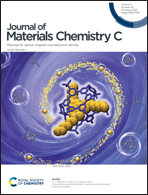Microwave-assisted foaming and sintering to prepare lightweight high-strength polystyrene/carbon nanotube composite foams with an ultralow percolation threshold†
Abstract
Lightweight, high-strength, and multifunctional polymer composite foams are urgently needed in numerous high-tech areas. Herein, we proposed a facile, clean, and energy-saving strategy to prepare the microcellular polystyrene/carbon nanotube (PS/CNT) composite foams with segregated conductive networks by an ingenious combination of microwave-assisted foaming and welding of expandable PS beads. The properties (e.g., expansion ratio, cellular structure, electrical conductivity, and fusion strength) of composite foams can be readily tailored by changing the CNT content and irradiation parameters. Benefiting from the unique structure of the microporous PS phases embedded in the conductive CNT networks, the 3D geometric PS/CNT foam part with a density of 0.095 g cm−3 showed an ultralow percolation threshold of 0.0014 vol% and a high specific electromagnetic interference shielding effectiveness (EMI SE) of 211.5 dB cm3 g−1 at 12.4 GHz with only 0.046 vol% CNT loading. The material presented an absorption-dominant shielding feature due to the synergistic action of the perfect CNT networks and the microcellular structure in PS beads. More importantly, the intense microwave sintering induced sufficient interdiffusion and entanglement across the interfacial regions among neighboring PS beads, thus providing the composite foams with a significantly enhanced compression stress of 7.1 MPa and a tensile strength of 2.2 MPa. Consequently, this study might offer a promising approach to manufacture high-performance and multifunctional composite foams for wearable electronic applications.



 Please wait while we load your content...
Please wait while we load your content...